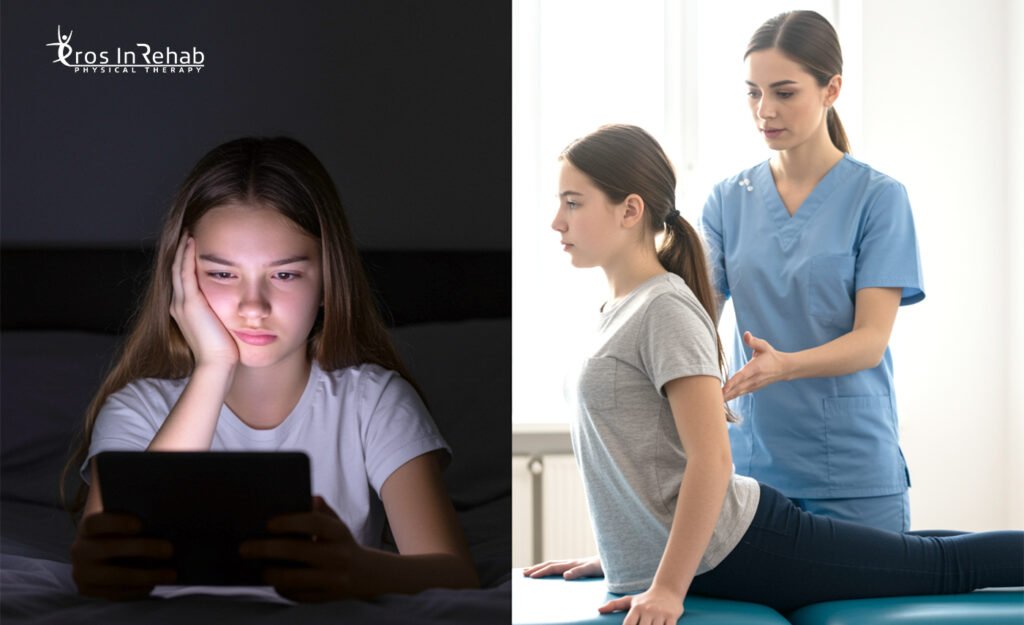In today’s digital world, adolescents spend more time than ever in front of screens. Whether it’s for school, gaming, or social media, this constant screen exposure is affecting more than just eyesight—it’s leading to a growing problem known as screen time syndrome. Characterized by poor posture, decreased physical activity, chronic pain, and mental fatigue, this modern health concern is becoming increasingly common among teens.
Thankfully, physical therapy services tailored to adolescents can help counter these effects. At Pros In Rehab, expert therapists are addressing this issue head-on through specialized adolescence physical therapy programs designed to restore balance, movement, and confidence in today’s tech-savvy generation.
What is Screen Time Syndrome?
Screen time syndrome refers to the cluster of physical and mental symptoms that arise from prolonged screen use. Some of the most common issues include:
✔ Poor posture (rounded shoulders, forward head).
✔ Neck and lower back pain.
✔ Eye strain and headaches.
✔ Decreased physical activity.
✔ Fatigue and difficulty focusing.
These symptoms may seem minor at first but can lead to long-term musculoskeletal imbalances and reduced quality of life if left unaddressed.
Why Adolescents Are Especially at Risk
Adolescence is a critical time for physical growth and development. As the body goes through rapid changes, poor habits—like slouching at a desk or staying inactive for long hours—can impact long-term health. When screen time replaces physical activity, teens can develop:
✔ Muscle weakness and joint stiffness.
✔ Balance and coordination issues.
✔ Poor postural alignment.
✔ Emotional stress and anxiety.
That’s why adolescent physical therapy is more important now than ever. Early intervention can prevent lasting physical problems and support healthier movement patterns.

How Physical Therapy Helps Teens Reclaim Their Health
At a trusted rehabilitation center like Pros In Rehab, physical therapists provide personalized care that goes beyond symptom relief. Here’s how therapy helps:
1. Posture Correction and Alignment
Therapists assess a teen’s posture and create specific exercises to improve spinal alignment, core strength, and muscle balance. By correcting posture, they reduce pain and help teens stand and sit more comfortably.
2. Encouraging Movement and Physical Activity
Structured movement programs help teens rebuild strength, improve flexibility, and develop endurance. Incorporating fun, age-appropriate exercises motivates adolescents to stay active beyond therapy sessions.
3. Supporting Mind-Body Wellness
Chronic screen use can affect mental well-being. Many physical therapists integrate mind and body therapy techniques—such as breathwork and gentle stretching—to relieve stress and improve focus.
4. Educating Teens and Families
Education is a key component of long-term success. Therapists work closely with both teens and their families to promote healthy habits, create better study environments, and reduce screen-related strain at home and school.

Tailored Adolescence Programs at Pros In Rehab
The adolescence program at Pros In Rehab is specifically designed to meet the unique physical and emotional needs of teenagers. It includes:
✔ Individual assessments and goal-setting.
✔ Therapeutic exercises to target posture and mobility.
✔ Strength and coordination training.
✔ Techniques to improve breathing, relaxation, and focus.
✔ Education on injury prevention and self-care.
This whole-body approach helps teens not only recover but thrive during a time of rapid growth and change.
Why Early Intervention Matters
The sooner screen-related issues are addressed, the easier they are to reverse. Adolescents who receive physical therapy early often experience:
✔ Better posture and reduced pain.
✔ Increased energy and focus.
✔ Higher confidence in their physical abilities.
✔ A foundation for healthier habits into adulthood.
Whether a teen is struggling with back pain, inactivity, or stress from digital overload, physical therapy offers a safe and effective solution.
Looking for Help? Start at Pros In Rehab
If you’ve noticed changes in your teen’s posture, activity level, or mood, it may be time to seek professional support. At Pros In Rehab, a leading provider of physical therapy services, your teen will receive personalized, compassionate care in a supportive environment.
Our experienced team understands the pressures today’s teens face and offers innovative, engaging solutions to help them move better, feel better, and live better.
FAQ
1. What is screen time syndrome, and how does it affect adolescents?
Answer: Screen time syndrome is a collection of physical and mental symptoms caused by prolonged screen use, including poor posture, neck and back pain, reduced activity levels, and mental fatigue. For adolescents, this can interfere with physical development, focus, and overall well-being.
2. How can physical therapy help my teen with screen-related issues?
Answer: Physical therapy addresses the root causes of screen time syndrome by correcting posture, strengthening weak muscles, improving flexibility, and encouraging movement. At a trusted physical therapy clinic near me like Pros In Rehab, therapists also educate teens on healthy habits to minimize screen-related strain.
3. What does an adolescence physical therapy program include?
Answer: An adolescence program typically includes postural assessments, therapeutic exercises, strength training, mobility work, and mind-body therapy techniques to support physical and emotional well-being. The goal is to help teens move better, feel better, and build lifelong healthy habits.
4. Is this type of therapy only for teens with pain or injury?
Answer: No. Adolescents don’t need to be injured to benefit. Therapy can also prevent future problems by addressing early signs of postural issues, inactivity, or mental fatigue related to excessive screen use.
5. Why choose Pros In Rehab for adolescent physical therapy?
Answer: Pros In Rehab offers expert-led, personalized care in a supportive environment. Their specialized programs focus on whole-body healing, combining physical therapy with wellness education to help teens thrive during this crucial stage of growth.
